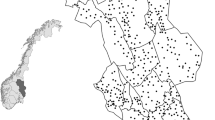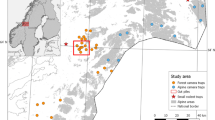Abstract
Variation in the distribution and abundance of animals in space and time are key concepts of population ecology. We studied these variations in a population of red foxes (Vulpes vulpes) in the tundra and taiga of northern Sweden. We analysed 12 years (1974–1985) of snow tracking data from a large area of 65,375 km2. Specifically, we evaluated to what extent the distribution of red foxes was explained by the presence of prey and how this interacted with snow depth and altitude. We also tested for temporal linear trends in the distribution and abundance of red foxes during the study period. The distribution of red foxes was explained by the presence of rodents, hares, tetraonid species, and ungulates (i.e. carcasses). Snow depth had a negative effect on the impact of small prey on the distribution of the red foxes, whereas it had a positive effect on the impact of ungulates. The influence of hares increased with altitude. Neither distribution nor abundance of red foxes showed a positive or negative linear trend, suggesting a stable population in northern Sweden during our study. This study showed that the distribution of red foxes was not only influenced by the presence of their main prey (rodents), but also by interactions between alternative prey, altitude, and snow depth. This study also emphasizes the importance of ungulate carcasses for red foxes and for wildlife management.


Similar content being viewed by others
References
Anderson DR, Burnham KP, White GC (1998) Comparison of Akaike information criterion and consistent Akaike information criterion for model selection and statistical inference from capture-recapture studies. J Appl Stat 25:263–282
Angelstam P, Lindström E, Widen P (1984) Role of predation in short-term population fluctuations of some birds and mammals in fennoscandia. Oecologia 62(2):199–208. doi:10.1007/bf00379014
Angerbjörn A et al (2013) Carnivore conservation in practice: replicated management actions on a large spatial scale. J Appl Ecol 50:59–67. doi:10.1111/1365-2664.12033
Barton KA, Zalewski A (2007) Winter severity limits red fox populations in Eurasia. Glob Ecol Biogeogr 16:281–289. doi:10.1111/j.1466-8238.2007.00299.x
Bates D, Maechler M, Bolker B, Walker S (2014) lme4: Linear mixed-effects models using Eigen and S4. R package version 1.1-7, http://CRAN.R-project.org/package=lme4
Begon M, Sait SM, Thompson DJ (1996) Predator–prey cycles with period shifts between two- and three-species systems. Nature 381:311–315. doi:10.1038/381311a0
Cagnacci F, Lovari S, Meriggi A (2003) Carrion dependence and food habits of the red fox in an Alpine area. Ital J Zool 70:31–38
Cederlund G, Bergstrom R (1996) Trends in the moose-forest system in Fennoscandia, with special reference to Sweden. In: DeGraaf RM, Miller RI (eds) Conservation of faunal diversity in forested landscapes. Chapman & Hall, London, pp 265–281
Chapron G et al (2014) Recovery of large carnivores in Europe’s modern human-dominated landscapes. Science 346(6216):1517–1519. doi:10.1126/science.1257553
Courchamp F, Langlais M, Sugihara G (1999) Cats protecting birds: modelling the mesopredator release effect. J Anim Ecol 68(2):282–292. doi:10.1046/j.1365-2656.1999.00285.x
Danell K, Hornfeldt B (1987) Numerical responses by populations of red fox and mountain hare during an outbreak of sarcoptic mange. Oecologia 73(4):533–536. doi:10.1007/bf00379412
Dell’Arte GL, Laaksonen T, Norrdahl K, Korpimäki E (2007) Variation in the diet composition of a generalist predator, the red fox, in relation to season and density of main prey. Acta Oecol-Int J Ecol 31:276–281. doi:10.1016/j.actao.2006.12.007
Elmhagen B, Rushton SP (2007) Trophic control of mesopredators in terrestrial ecosystems: top-down or bottom-up? Ecol Lett 10:197–206. doi:10.1111/j.1461-0248.2006.01010.x
Englund J (1970) Some aspects of reproduction and mortality rates in Swedish foxes (Vulpes vulpes) 1961–63 and 1966–69. Viltrevy 8:1–82
ESRI (2009) ARCGIS desktop. Environmental Systems Research Institute, Redland
Fahrig L (2003) Effects of habitat fragmentation on biodiversity. Annu Rev Ecol Evol Syst 34:487–515
Fuglei E, Ims RA (2008) Global warming and effects on the Arctic fox. Sci Prog 91(Pt 2):175–191. doi:10.3184/003685008x327468
Gallant D, Slough BG, Reid DG, Berteaux D (2012) Arctic fox versus red fox in the warming Arctic: four decades of den surveys in north Yukon. Polar Biol 35:1421–1431. doi:10.1007/s00300-012-1181-8
Gelman A, Hill J (2007) Data analysis using regression and multilevel/hierarchical models. Analytical methods for social research. Cambridge University Press, Cambridge
Halpin MA, Bissonette JA (1988) Influence of snow depth on prey availability and habitat use by red fox. Can J Zool 66:587–592. doi:10.1139/z88-086
Hartova-Nentvichova M, Salek M, Cerveny J, Koubek P (2010) Variation in the diet of the red fox (Vulpes vulpes) in mountain habitats: effects of altitude and season. Mamm Biol 75:334–340. doi:10.1016/j.mambio.2009.09.003
Henden JA, Ims RA, Yoccoz NG (2009) Nonstationary spatio-temporal small rodent dynamics: evidence from long-term Norwegian fox bounty data. J Anim Ecol 78:636–645. doi:10.1111/j.1365-2656.2008.01510.x
Henden JA, Ims RA, Yoccoz NG, Hellström P, Angerbjörn A (2010) Strength of asymmetric competition between predators in food webs ruled by fluctuating prey: the case of foxes in tundra. Oikos 119:27–34. doi:10.1111/j.1600-0706.2009.17604.x
Henden JA, Stien A, Bårdsen BJ, Yoccoz NG, Ims RA (2014) Community-wide mesocarnivore response to partial ungulate migration. J Appl Ecol 51(6):1525–1533. doi:10.1111/1365-2664.12328
Hersteinsson P, Macdonald DW (1992) Interspecific competition and the geographical distribution of red and arctic foxes vulpes-vulpes and alopex-lagopus. Oikos 64:505–515. doi:10.2307/3545168
Hersteinsson P, Angerbjörn A, Frafjord K, Kaikusalo A (1989) The arctic fox in fennoscandia and iceland: management problems. Biol Conserv 49:67–81. doi:10.1016/0006-3207(89)90113-4
Ims RA, Yoccoz NG, Bråthen KA, Fauchald P, Tveraa T, Hausner V (2007) Can reindeer overabundance cause a trophic cascade? Ecosystems 10:607–622. doi:10.1007/s10021-007-9060-9
Jedrzejewski W, Jedrzejewska B (1992) Foraging and diet of the red fox vulpes vulpes in relation to variable food resources in bialowieza-national-park, poland. Ecography 15:212–220. doi:10.1111/j.1600-0587.1992.tb00027.x
Jonsell U, Hock R, Duguay M (2013) Recent air and ground temperature increases at Tarfala Research Station, Sweden. Polar Res 32. doi:10.3402/polar.v32i0.19807
Kauhala K, Helle P (2000) The interactions of predator and hare populations in Finland - a study based on wildlife monitoring counts. Ann Zool Fenn 37(3):151–160
Killengreen ST, Ims RA, Yoccoz NG, Brathen KA, Henden J-A, Schott T (2007) Structural characteristics of a low Arctic tundra ecosystem and the retreat of the Arctic fox. Biol Conserv 135:459–472. doi:10.1016/j.biocon.2006.10.039
Killengreen ST, Lecomte N, Ehrich D, Schott T, Yoccoz NG, Ims RA (2011) The importance of marine vs. human-induced subsidies in the maintenance of an expanding mesocarnivore in the arctic tundra. J Anim Ecol 80:1049–1060. doi:10.1111/j.1365-2656.2011.01840.x
Kjellander P, Nordström J (2003) Cyclic voles, prey switching in red fox, and roe deer dynamics—a test of the alternative prey hypothesis. Oikos 101:338–344. doi:10.1034/j.1600-0706.2003.11986.x
Krebs CJ, Boutin S, Boonstra R, Sinclair A, Smith J, Dale M, Martin K, Turkington R (1995) Impact of food and predation on the snowshoe hare cycle. Science 269:1112–1115. doi:10.1126/science.269.5227.1112
Kurki S, Nikula A, Helle P, Lindén H (1998) Abundances of red fox and pine marten in relation to the composition of boreal forest landscapes. J Anim Ecol 67:874–886. doi:10.1046/j.1365-2656.1998.6760874.x
Lariviere S, Pasitschniak-Arts M (1996) Vulpes vulpes. Mamm Species 537:1–11
Lavsund S, Nygren T, Solberg EJ (2003) Status of moose populations and challenges to moose management in Fennoscandia. Alces 39:109–130
Lindström E (1983) Condition and growth of red foxes (vulpes-vulpes) in relation to food-supply. J Zool 199:117–122
Lindström E (1989) Food limitation and social regulation in a red fox population. Holarct Ecol 12:70–79
Lindström E, Mörner T (1985) The spreading of sarcoptic mange among swedish red foxes (vulpes-vulpes l) in relation to fox population-dynamics. Rev Ecol Terre La Vie 40:211–216
Lindström E, Angelstam P, Widen P, Andren H (1987) Do predators synchronize vole and grouse fluctuations?: an experiment. Oikos 48(2):121–124
Lindström E, Andrén H, Angelstam P, Cederlund G, Hörnfeldt B, Jäderberg L, Lemnell PA, Martinsson B, Sköld K, Swenson JE (1994) Disease reveals the predator: sarcoptic mange, red fox predation, and prey populations. Ecology 75:1042–1049. doi:10.2307/1939428
Lönnberg E (1926) Fjällrävstammen i Sverige 1926. Kungl. Svenska Vetenskapsakademiens skrifter i naturskyddsärenden, 0374–8820; 7. Almqvist & Wiksell
Marcström V, Kenward RE, Engren E (1988) The impact of predation on boreal tetraonids during vole cycles: an experimental study. J Anim Ecol 57:859–872. doi:10.2307/5097
Michal B, Rafal Z (2014) Responses of small mammals to clear-cutting in temperate and boreal forests of Europe: a meta-analysis and review. Eur J For Res 133:1–11. doi:10.1007/s10342-013-0726-x
Moen J, Danell O (2003) Reindeer in the Swedish mountains: an assessment of grazing impacts. Ambio 32:397–402. doi:10.1639/0044-7447(2003)032[0397:ritsma]2.0.co;2
Mörner T (1992) Sarcoptic mange in Swedish wildlife. Rev Sci Tech 11:1115–1121
Nakagawa S, Schielzeth H (2013) A general and simple method for obtaining R2 from generalized linear mixed-effects models. Methods Ecol Evol 4:133–142. doi:10.1111/j.2041-210x.2012.00261.x
Needham R, Odden M, Lundstadsveen SK, Wegge P (2014) Seasonal diets of red foxes in a boreal forest with a dense population of moose: the importance of winter scavenging. Acta Theriol 59:391–398. doi:10.1007/s13364-014-0188-7
Osenberg CW, Mittelbach GG (1996) The relative importance of resource limitation and predator limitation in food chains. In: Polis A, Winemiller KO (eds) Food webs: integration of patterns and dynamics. Chapman and Hall, pp 134–148
Persson L, Bengtsson J, Menge BA, Power ME (1996) Productivity and consumer regulation—concepts, patterns, and mechanisms. In: Polis A and Winemiller KO (ed) Food webs: integration of patterns and dynamics. Chapman and Hall, pp 396–434
Post DM, Conners ME, Goldberg DS (2000) Prey preference by a top predator and the stability of linked food chains. Ecology 81:8–14. doi:10.1890/0012-9658(2000)081[0008:ppbatp]2.0.co;2
Post E et al (2009) Ecological dynamics across the arctic associated with recent climate change. Science 325:1355–1358. doi:10.1126/science.1173113
Prugh LR, Stoner CJ, Epps CW, Bean WT, Ripple WJ, Laliberte AS, Brashares JS (2009) The rise of the mesopredator. Bioscience 59:779–791. doi:10.1525/bio.2009.59.9.9
R Development Core Team (2012) R: a language and environment for statistical computing, 2151st edn. R Foundation for Statistical Computing, Vienna
Ritchie EG, Johnson CN (2009) Predator interactions, mesopredator release and biodiversity conservation. Ecol Lett 12:982–998. doi:10.1111/j.1461-0248.2009.01347.x
Rosalino LM, Sousa M, Pedroso NM, Basto M, Rosario J, Santos MJ, Loureiro F (2010) The influence of food resources on red fox local distribution in a mountain area of the western mediterranean. Vie Et Milieu Life Environ 60:39–45
Saether BE, Andersen R, Hjeljord O, Heim M (1996) Ecological correlates of regional variation in life history of the moose Alces alces. Ecology 77(5):1493–1500. doi:10.2307/2265546
Selås V, Vik JO (2006) Possible impact of snow depth and ungulate carcasses on red fox (Vulpes vulpes) populations in Norway, 1897–1976. J Zool 269:299–308. doi:10.1111/j.1469-7998.2006.00048.x
Selås V, Vik JO (2007) The arctic fox Alopex lagopus in Fennoscandia: a victim of human-induced changes in interspecific competition and predation? Biodivers Conserv 16:3575–3583. doi:10.1007/s10531-006-9118-6
Smedshaug CA, Selås V, Lund SE, Sonerud GA (1999) The effect of a natural reduction of red fox Vulpes vulpes on small game hunting bags in Norway. Wildl Biol 5:157–166
Statistics Sweden (SCB) (2015). http://www.scb.se/en_/Finding-statistics/Statistics-by-subject-area/Population/Population-composition/Population-statistics/. Accessed 7 Dec 2015
Tveraa T, Fauchald P, Henaug C, Yoccoz NG (2003) An examination of a compensatory relationship between food limitation and predation in semi-domestic reindeer. Oecologia 137(3):370–376. doi:10.1007/s00442-003-1373-6
Walther GR, Post E, Convey P, Menzel A, Parmesan C, Beebee TJC, Fromentin JM, Hoegh-Guldberg O, Bairlein F (2002) Ecological responses to recent climate change. Nature 416:389–395. doi:10.1038/416389a
Zimen E (1980) The red fox (Biogeographica; v.18). Springer, Netherlands. doi:10.1007/978-94-017-5592-4
Acknowledgments
We would like to thank Robert Franzén in the Swedish Environmental Protection Agency for providing access to the entire wildlife census data used in this paper.
Author information
Authors and Affiliations
Corresponding author
Rights and permissions
About this article
Cite this article
Carricondo-Sanchez, D., Samelius, G., Odden, M. et al. Spatial and temporal variation in the distribution and abundance of red foxes in the tundra and taiga of northern Sweden. Eur J Wildl Res 62, 211–218 (2016). https://doi.org/10.1007/s10344-016-0995-z
Received:
Revised:
Accepted:
Published:
Issue Date:
DOI: https://doi.org/10.1007/s10344-016-0995-z




